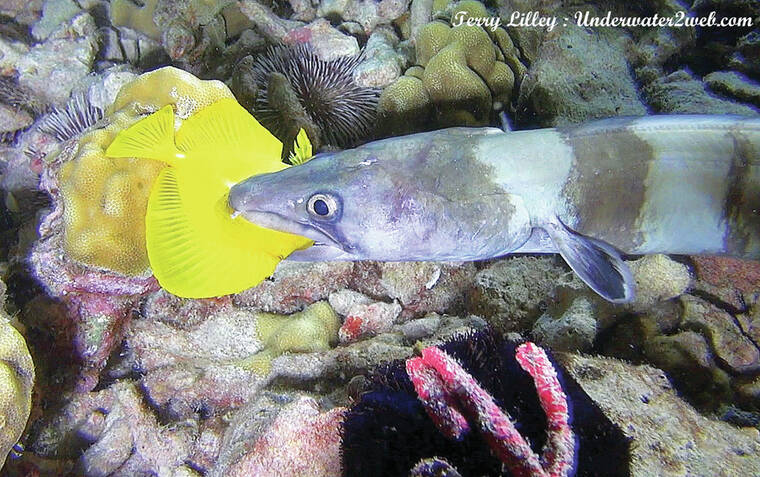In our ocean it is common for one fish species to hunt with a different species if the outcome is food for the both of them. Roi often hunts with moray eels and papio often hunts with weke, the goatfish. Even large sharks hunt with large barracuda from time to time.
Humans have only been underwater in the sea for a very short period of time compared to the fish that live in Hawai‘i, but some fish species have learned to hunt with human divers within the last 30 years! I captured on video a rare event where moray eels have learned to hunt with scuba divers that are shooting video of hahalua the manta ray.
The invention of the underwater dive light has changed our marine life here in Hawai‘i at several dive sites just within the last 20 years, and the best place to see this is on the Big Island of Hawai‘i at the manta ray dive sites along the Kona Coast. At night, several dive companies have been using bright lights to attract krill (small shrimp) to the surface, and the large manta rays come in to feed on the krill. Divers go into the water at night to take pictures and video of the manta rays feeding. This event has become so popular that it has been in the newspaper lately because way too many people are in the water at night at the same time, which could be dangerous and also affect the natural feeding of the manta rays.
I went on the night time manta ray dive and did a nice movie about this one-of-a-kind manta ray adventure, but I also captured on video a different marine-life event that I was surprised to see.
While scuba diving with friends looking up toward the surface to watch the mantas feed, I had an eerie feeling that we were being watched from below. Sure enough, I looked down at the coral reef right below us and saw five to six large, four-foot-long moray eels that had surrounded us within a few feet of our feet. I immediately thought, why were these morays with very sharp teeth following us divers, because these eels are normally afraid of divers.
I shined my bright video light on one of the morays to shoot some video, and was surprised at what I saw. My bright light was pointed at a yellow tang that was sleeping on the reef, and the moray zoomed over and grabbed the yellow tang right when my light was shining in the tang’s eyes. The eel grabbed the fish and swallowed it whole. Next to that yellow tang I found another one sleeping in a crack in the reef, and shined my light on it, blinding the tang and, sure enough, a different moray eel zoomed over and grabbed the tang with its large teeth!
There are divers almost every night at this manta ray dive site with bright lights, and the moray eels figured out that the fish sleeping on the reef were blinded by the bright lights, and they took advantage of this to catch an easy meal. I was amazed at how the eels had learned to take advantage of humans being underwater at night with bright lights.
Everything on Earth changes every minute because the Earth is spinning, and all wildlife must adapt to these changes to survive. Nothing in nature ever stays the same, so the moray eels learned to change their feeding patterns due to the introduction of humans into their night time marine habitat.
You can see the puhi in action feeding up on my marine life series on my YouTube at Underwater2web and also see my upcoming manta ray movie I shot along the Kona Coast and also in Socorro, Mexico.
•••
Terry Lilley is a marine biologist living in Hanalei. He is co-founder of Reef Guardians Hawai‘i, a nonprofit on a mission to provide education and resources to protect the coral reef. To donate to Reef Guardians Hawaii go to www.reefguardianshawaii.org.




